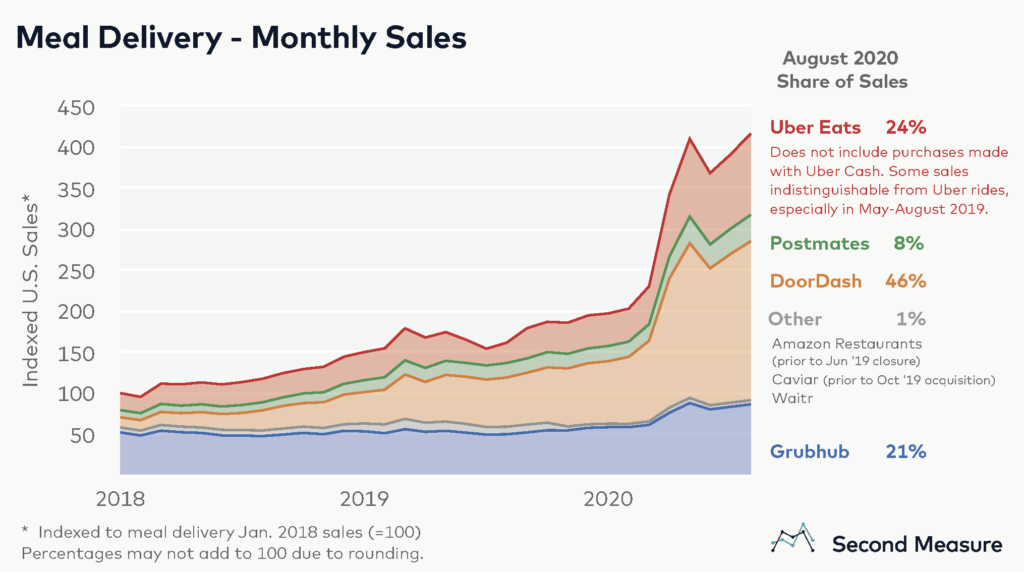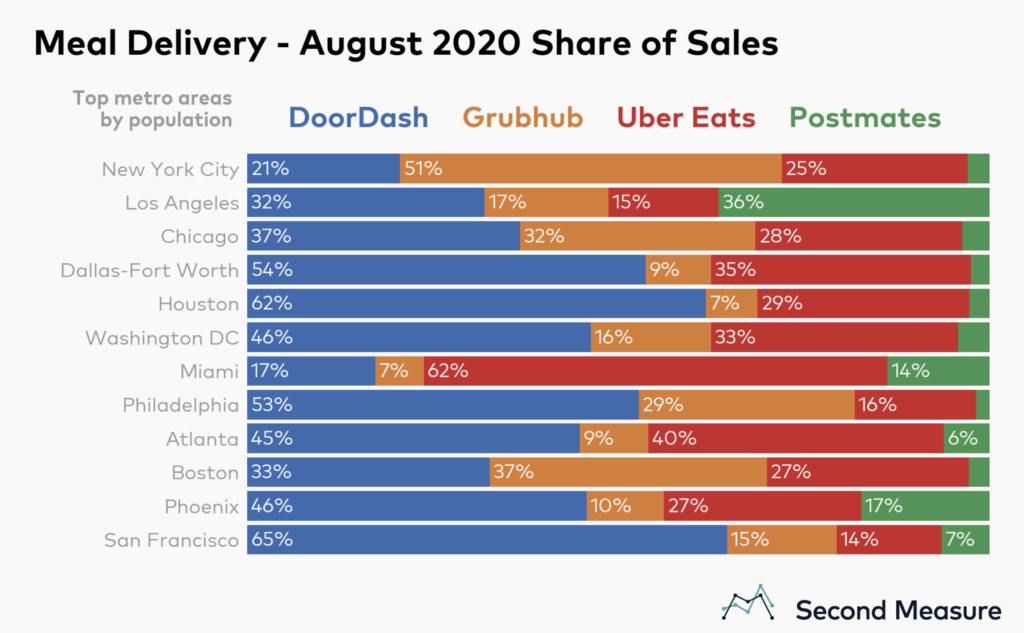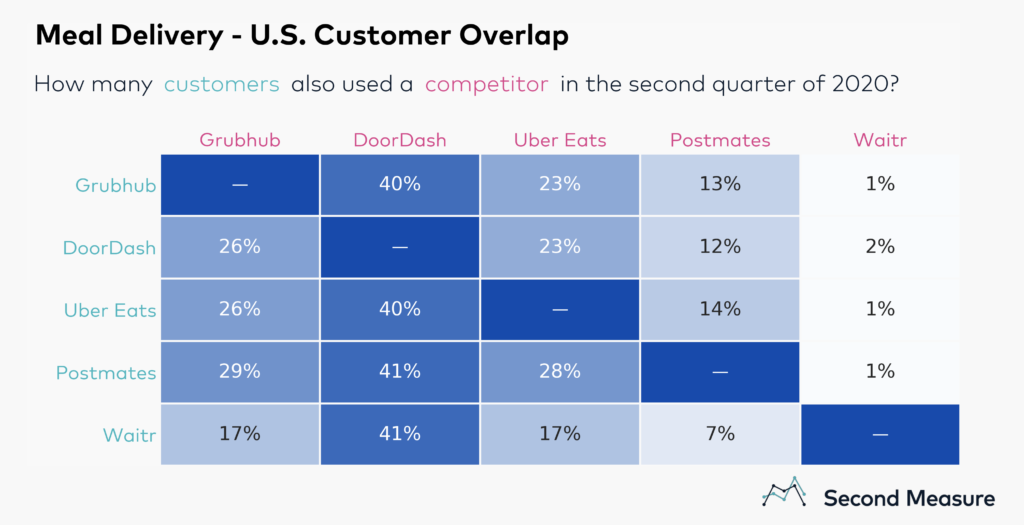Read the full article on Second Measure
When many Americans sheltered in their homes early in the coronavirus pandemic, meal delivery sales reached new heights. Our data reveals that in August, sales for meal delivery services grew 158 percent year-over-year, collectively.
Shelter-in-place orders may also be driving more Americans to make their first meal delivery purchase. In August, 33 percent of American consumers had ever ordered from one of the services in our analysis, up from 26 percent a year ago.

These thriving businesses are in the spotlight during the COVID-19 era—and with recent news that Grubhub is to be acquired by Just Eat Takeaway for $7.3 billion while Uber plans to acquire Postmates in an attempt to consolidate market share and boost profitability. The company is also seeking ways to diversify its existing business strategy, and recently announced plans to launch a U.S. grocery delivery service in July. Meanwhile, DoorDash’s partnership with CVS marks the company’s first foray into grocery delivery.
DoorDash and its subsidiaries earned 46 percent of U.S. consumers’ meal delivery sales in August, while our data indicates Uber Eats edged out Grubhub for second place with 24 percent. It’s worth noting that our sales metrics may differ from publicly reported earnings for a number of reasons. First, some Uber Eats transactions are indistinguishable from Uber Rides transactions in Second Measure’s data, and this issue was especially pronounced from May 2019 to mid-August 2019. Additionally, Second Measure’s data does not include Uber Eats’ purchases made using Uber Cash or purchases made by corporate customers, an area where Uber Eats is reportedly making inroads. Our analysis includes aggregated debit and credit card purchases from a panel of millions of anonymized U.S. consumers.
Grubhub and its subsidiaries, which include Seamless and Eat24, came in around 21 percent of U.S. meal delivery consumer spending in August. (Purchases made through LevelUp, which Grubhub acquired in late 2018, are not included in our analysis. Neither are college student meal plan purchases made through Grubhub subsidiary Tapingo.)
The fourth major U.S. meal delivery company, Postmates, confidentially filed for an IPO last winter and raised $225 million last fall. But CEO Bastian Lehmann declined to say when the company would move forward with its IPO, citing “choppy” market conditions. Postmates earned 8 percent of the U.S. meal delivery market in August.
One of the industry’s smaller services, Waitr, earned 1 percent of national sales. In January, the company announced plans to lay off all drivers in favor of using contractors. The change comes weeks after Waitr installed a new CEO as it tries to boost share prices and remain listed on Nasdaq.
Grubhub and DoorDash control different parts of the country
The top two food delivery services may be close in U.S. market share, but their strongholds are in different regions. Grubhub is the most popular service in many Northeastern metro areas, including Boston and New York. DoorDash rakes in more than half the sales in the two biggest Texas metro areas, Dallas-Fort Worth and Houston, and it’s approaching two-thirds of the market share in its Bay Area home turf.

Subscription meals have appeal
As meal delivery services look for new ways to grow in cities big and small, one emerging answer is subscriptions. In February, Grubhub announced its answer to Postmates Unlimited (launched in 2016) and DoorDash DashPass (launched in 2018). Notably, in December 2019, DoorDash partnered with Chase to give free DashPass memberships to millions of credit card holders. (These free memberships are not included in Second Measure’s data.) Uber is also testing various subscription plans for food, rides, bikes, and scooters.
In August, 18 percent of Postmates customers were subscribers, a proportion that’s grown slightly over the past year. DashPass attracted 19 percent of DoorDash’s customers, not including the promotional memberships they offered Chase users.
Companies vie for restaurant partners
Another very popular growth strategy for meal delivery companies has been forming partnerships with the nation’s top chain restaurants. (Though many services have also recently been in the news for listing restaurants that do not want partnerships.) In January, DoorDash officially teamed up with Little Caesars Pizza, a brand that has never previously offered delivery. DoorDash has other deals with Wendy’s, Chick-fil-A, and McDonald’s, the biggest fast food chain in the country, which also offers delivery with Uber Eats.
Starbucks has a contract with Uber Eats, Popeyes with Postmates, and Taco Bell and KFC with Grubhub. Yet, as Uber Eats and Grubhub public filings show, partnerships don’t always lead to revenue. Often, partners pay the delivery services lower fees, decreasing their take rates or even causing them to lose money. But the partners often have huge customer pools, many locations and impressive advertising reach, all of which have delivery services betting that joining forces will pay off in the long term.
The partnerships are paying off for many of the restaurants. The Cheesecake Factory and Chipotle have publicly credited DoorDash with boosting their revenue. In August, Second Measure data shows 23 percent of The Cheesecake Factory’s sales came through DoorDash (before subtracting DoorDash’s cut or the delivery tip), dropping from 25 percent a month ago. The delivery service accounted for 10 percent of August sales at Buffalo Wild Wings, and 13 percent at Chipotle.
Fewer customers are loyal to a single service
Despite overall industry growth, the battle for customers is getting more intense because fewer of today’s diners are loyal to just one service. (Grubhub’s CEO has cited “promiscuous customers” as a hindrance to his company’s growth.) In the second quarter of 2018, 73 percent of Grubhub’s customers didn’t use other meal delivery services. Two years later, it’s fallen to 45 percent, as competing services woo customers with different restaurant offerings and promotional prices.
Postmates has the lowest percentage of exclusive customers (35 percent). DoorDash saw 51 percent of customers use them exclusively in the second quarter of 2020, and for Uber Eats, it was 42 percent. All the services in our analysis have a lower percentage of exclusive customers than they did two years ago.

Not surprisingly, the biggest meal delivery services are also the most likely to share customers. Around 40 percent of each company’s diners also ordered food from top competitor DoorDash in the second quarter of 2020.
As more restaurants form exclusive delivery partnerships, more diners are going to have to hop between apps to cover all their favorite takeout spots. The least loyal customers, it seems, will also be the most well fed.
